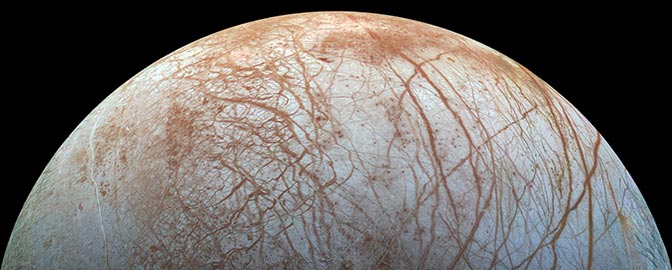Scientists behind threatened NASA missions explain what’s at stake
On May 30, 2025, the White House announced a plan to cancel 41 space missions — including spacecraft already paid for, launched, and making discoveries — as part of a devastating 47% cut to NASA’s science program.
To learn what’s at stake, The Planetary Society interviewed some of the scientists behind these missions and their discoveries. These are world-class experts who are speaking from personal experience. In many cases, they have devoted decades of their lives to these missions.
Here is what they have to say, in their own words.
A full guide to the NASA missions at risk is available here.

Daniella DellaGiustina — OSIRIS-APEX
NASA’s OSIRIS-APEX (Origins, Spectral Interpretation, Resource Identification, and Security – APophis EXplorer) is a probe currently on its way to intercept the asteroid Apophis. Daniella DellaGiustina, PhD, is the mission’s principal investigator and a professor at the University of Arizona's Lunar and Planetary Laboratory.
In one sentence, what does OSIRIS-APEX aim to do?
OSIRIS-APEX capitalizes on the exceptionally rare 2029 Earth flyby of the potentially hazardous asteroid Apophis to advance planetary defense strategies and reveal how Earth’s gravity alters an asteroid’s surface and interior.
What potential discoveries are at stake if OSIRIS-APEX is defunded or cancelled?
Canceling the mission would forfeit our only in-flight opportunity — and NASA’s sole planned mission — to observe how Earth’s gravity affects the near-Earth asteroid Apophis during its once-in-7,500-year encounter. We would lose crucial insights into asteroid surface evolution, impact risk, and planetary defense mitigation strategies.
How does OSIRIS-APEX fit into NASA’s overall mission?
OSIRIS-APEX directly advances NASA’s goals in planetary defense, solar system exploration, and spacecraft reusability by enabling transformative science at low cost — repurposing the existing OSIRIS-REx spacecraft for a new mission.
Why should this mission matter to people?
On Friday, April 13, 2029, asteroid Apophis will fly by the Earth at one-tenth the distance from the Earth to Moon, closer than geosynchronous satellites, and will be naked-eye visible to two billion people worldwide. This will be the largest object to pass Earth this closely in recorded history. OSIRIS-APEX protects our future. What we learn from Apophis could help safeguard Earth from asteroid threats, inform resource extraction strategies on small bodies, and inspire the next generation through a dramatic and accessible planetary encounter.
How many people are on your team?
170.
How many states are represented by the mission team?
12.
Shannon Curry — MAVEN
NASA’s MAVEN (Mars Atmosphere and Volatile EvolutioN) spacecraft is currently in orbit around Mars. Shannon Curry, PhD, is the mission’s principal investigator and a professor of astrophysics and planetary sciences at the University of Colorado, Boulder.
In one sentence, what does MAVEN aim to do?
MAVEN is America's premiere telecommunications orbiter at Mars and is the best observer of atmospheric escape anywhere in the Solar System.
What potential discoveries are at stake if MAVEN is defunded or cancelled?
MAVEN is the best and only spacecraft from any space agency to provide information about the history of Mars’ atmosphere. We can use this information to understand the future of Earth’s atmosphere, and which planets in the Solar System (and beyond) may be able to support life on their surfaces.

How does MAVEN fit into NASA’s overall mission?
MAVEN returns data from[sic] Mars rovers and serves as an exceptional observatory for exploring Mars. It is exploring the past, present and future of the red planet. MAVEN is also the only mission that can provide real time data on the radiation environment and solar storms at Mars, which will be critical to monitor in advance of human exploration.
Why should this mission matter to people?
MAVEN is the youngest and strongest U.S. telecom relay at Mars. Without a strong U.S. presence, America will cede leadership of Mars exploration to China.
How many people are on your team?
Roughly 350 people work on MAVEN.

Stephen Kane — DAVINCI
NASA’s DAVINCI (Deep Atmosphere Venus Investigation of Noble gases, Chemistry, and Imaging) is a planned atmospheric descent probe to Venus. Stephen Kane, PhD, is a member of the mission’s science team and a professor of planetary astrophysics at the University of California, Riverside.
In one sentence, what does DAVINCI aim to do?
The DAVINCI mission is an atmospheric probe that will be deployed to our sister planet, Venus, and provide the first detailed measurements of the composition and chemistry of the atmosphere all the way down to the surface of the planet, as well as imaging some of the oldest terrain on its surface.
What potential discoveries are at stake if DAVINCI is defunded or cancelled?
Venus research is fundamental to understanding how planets evolve through time. Although Venus is the same size as Earth and often referred to as our twin planet, the surface of Venus is frequently considered to be the most hostile environment that exists within the solar system. However, Venus likely once had surface conditions similar to Earth, complete with oceans, and we still don't understand how it became the hellscape we see today.
How does DANVINCI fit into NASA’s overall mission?
First, the study of Venus is the study of Earth, since Venus is Earth's twin and yet underwent a very different evolution. Second, Venus is one of only a handful of terrestrial bodies within the solar system with a substantial atmosphere, and so the science of how Venus produced and maintains its atmosphere is a major component to understanding terrestrial planet evolution as a whole.
Third, Venus is a fundamental part of the NASA astrobiology story. We don't know how or why Venus diverged from a habitable state. Analysis of exoplanet atmospheres will rely heavily upon models that are built from in situ data acquired here in the Solar System, but those models are woefully incomplete due to lack of data for the Venusian deep atmosphere. Indeed, many exoplanets may be in a state like Venus, but we may fail to recognize such planets without adequate understanding of the Earth-sized planet right next to us.
Why should this mission matter to people?
The missions to Venus represent a giant step forward in planetary science that push the boundaries of studying Venus significantly further than ever before. Also, the technology needed to overcome the challenges of the hostile Venus environment are resulting in numerous advances in our understanding of material tolerances and behavior in high temperature and pressure conditions.
America has fallen behind in Venus science over several decades, but the combination of science and technology that are being pushed forward by these missions will ensure that the United States of America regains and preserves its leadership in the study of our sister planet. Furthermore, the missions and their frequent discoveries will inspire a new generation to pursue science and technology research that will greatly benefit our country.

Scott Bolton - Juno
NASA’s Juno spacecraft is currently in orbit around Jupiter. Scott Bolton, PhD, is the mission’s principal investigator and associate vice president of Southwest Research Institute's Space Science and Engineering Division.
In one sentence, what does the mission you’re working on aim to do?
Initially focusing on Jupiter’s interior, atmosphere and aurora, [Juno] has expanded during its extended mission to be a full system explorer capable of investigating the Galilean satellites, rings, inner moons, radiation belts, and boundaries of Jupiter’s magnetosphere.
What potential discoveries are at stake if Juno is defunded or cancelled?
Juno provides a unique opportunity to investigate previously unexplored regions of the Jovian system. Its next phase includes close flybys of the moons Thebe, Amalthea, Adrastea, and Metis. In addition to scientific exploration, Juno is providing critical new information directly relevant to national security by teaching us how space systems can survive and even reverse degradation from exposure to intense radiation.
How does Juno fit into NASA’s overall mission?
In addition to helping to lay a foundation for NASA’s Europa Clipper and ESA’s Jupiter Icy Moons Explorer (JUICE) missions enroute to Jupiter, Juno is providing the basis of understanding to compare the characteristics of Jupiter with the other giant planets in the Solar System: Saturn, Uranus and Neptune. This is vital for our understanding of Solar System formation and evolution, and for understanding planetary systems throughout the galaxy.
Why should this mission matter to people?
Continuing NASA’s Juno mission is a strategic investment in planetary science, offering continued insights into the Jupiter system and informing future exploration missions. The mission’s unique capabilities, cost-effectiveness, and alignment with strategic priorities make it an invaluable asset to the scientific community and the nation’s space exploration goals.
How many people are on your team?
There are about 200 people working on Juno, mostly part time.
How many states are represented by the Juno team?
10 states.

Darby Dyar — VERITAS
NASA’s VERITAS (Venus Emissivity, Radio Science, InSAR, Topography, and Spectroscopy) is a planned Venus orbiter. Darby Dyar, PhD, is the mission’s deputy principal investigator, a professor of astronomy at Mount Holyoke College, and a senior scientist at the Planetary Science Institute.
In one sentence, what does VERITAS aim to do?
VERITAS will create unprecedented, global, high-resolution datasets [of Venus] designed to answer a fundamental question for rocky planets: how did Earth and her twin Venus evolve into two entirely [different] examples of planetary habitability?
What potential discoveries are at stake if VERITAS is defunded or cancelled?
VERITAS will be the first mission to search for the fingerprint of prolonged surface water [on Venus], find out if there are abundant active volcanoes, assess whether Venus today has some of the same process[es] as formed in Earth’s first 1-2 billion years and shaped its evolution, and determine why Venus has no magnetic field[, among other things].
VERITAS is poised to make discoveries beyond what we can imagine today. Ultimately, VERITAS addresses whether our home planet is unique, how Venus and Earth evolve over time, and how likely we are to find Earthlike planets around other suns.
Why should this mission matter to people?
VERITAS is a once-in-a generation mission. [It will] pioneer new spacecraft navigation and will utilize machine learning (AI) to both improve orbit knowledge and the ability to navigate precisely around planetary bodies. VERITAS will generate critical datasets at 10–100× the resolution of existing data, strengthening ties with space-faring allies. [It will be] an inspiration and resource for the next generation of STEM workers.
How many people are on your team?
In the US currently ~100 people work on VERITAS. Similar numbers of people are working on the mission as part of our international partner contributions.
Clive Neal — VIPER
NASA’s VIPER (Volatiles Investigating Polar Exploration Rover) is a Moon rover that was already built when NASA cancelled the mission in 2024. However, NASA is now in discussions with U.S. companies about possibly reviving the mission through a partnership. Clive Neal, PhD, is a professor of Civil and Environmental Engineering and Earth Sciences at the University of Notre Dame.
What potential discoveries are at stake if VIPER never makes it to the Moon?
VIPER represents the only U.S. lunar mission with mobility that will inform us about lunar water ice in permanently shaded regions (PSRs) at the lunar south pole. [Without VIPER,] the U.S. would cede resource prospecting and maybe even human exploration of the Moon to other nations, as these resources could sustain humans on the Moon.
How does VIPER fit into NASA’s overall mission?
VIPER is integral to the International Lunar Resources Prospecting Campaign. It gives the first ground truth to orbital data regarding [the] presence/absence of water ice at the [lunar] south pole and will make predictive site determinations using orbital data more robust. Without "prospecting," use of water ice [on the Moon] is a fantasy.
Why should this mission matter to people?
The VIPER mission represents so many "firsts" for America: the first semi-autonomous U.S. robotic rover on the Moon, the first mission to visit a PSR, and the first surface mission dedicated to prospecting [on the Moon].
VIPER has the ability to make life better on Earth by showing the potential for job growth and new technologies that would be required to utilize lunar water ice.
How many states are represented by the VIPER team?
10.

Paul Byrne — EnVision
The European Space Agency’s EnVision spacecraft is a planned Venus orbiter. Paul Byrne, PhD, is a member of the mission’s science study team and a professor of Earth, environmental, and planetary sciences at the Washington University in St. Louis. NASA is a key partner in the mission and is contributing an important instrument to the spacecraft, called VenSAR.
In one sentence, what does EnVision aim to do?
Help answer questions about the history, geology, and climate of Venus.
What potential discoveries are at stake if EnVision is defunded or cancelled?
The EnVision mission will address questions as fundamental as whether Venus was once habitable, and whether (and to what extent) geological processes are taking place there today.
How does EnVision fit into NASA’s overall mission?
One of NASA's core missions is the pursuit of scientific questions related to planetary formation and evolution, including our very own world. Choosing to no longer provide the VenSAR instrument [to EnVision] directly strikes at one of the primary reasons for why NASA exists — to explore the cosmos and, ultimately, help answer why we're here and whether we're alone.
Why should this mission matter to people?
Venus is the only other Earth-size world we will ever send spacecraft to. If we're to fully understand Earth's own habitability and the origin of life here, then understanding what made modern, hellish Venus so different is key. EnVision has the ability to tackle and answer some of these questions, providing new information not only on why our nearest planetary neighbor is so un-Earth-like, but why our own world has managed to remain hospitable for billions of years.
How many people are on your team?
Likely several dozen, at least.
More at stake
The missions described here are just a few of the dozens put at risk of being defunded or canceled. The new budget proposal would shut down New Horizons, the first spacecraft to fly by Pluto up close, while it is actively exploring the outermost reaches of the Solar System. It would drop Mars Sample Return, NASA’s years-long effort to bring back the first samples from another planet. It would turn off some of the most powerful space telescopes ever built, and lead to job losses, stalled innovation, and setbacks for U.S. space leadership.
We are encouraging Congress to reject the White House’s plan and organizing ways you can show elected officials that space science and exploration matter. If enough people take action, there is still time to save NASA science from this extinction-level event.
Support our core enterprises
Your gift today will go far to help us close out the year strong and keep up our momentum in 2026.
Donate

 Explore Worlds
Explore Worlds Find Life
Find Life Defend Earth
Defend Earth







